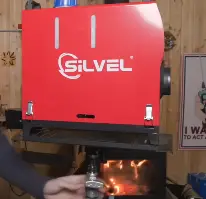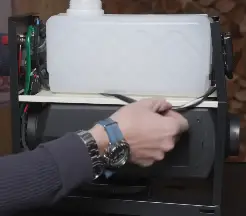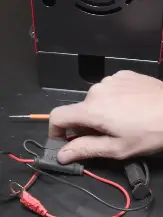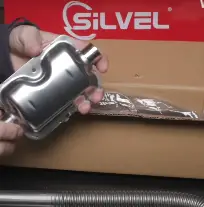Picture this: you’re out in the wilderness, the temperature’s dipping below freezing, and you’re craving warmth in your RV or tent. That’s where the Silvel 12V 8KW Diesel Heater comes in—a game-changer for anyone needing reliable, portable heat. I’ve been using this heater for months, and let me tell you, it’s a lifesaver. Whether you’re a van-lifer, camper, or just need to heat a garage, this compact powerhouse delivers. Trust me, if you’re after efficient heating without breaking the bank, the Silvel is worth every penny. Let’s dive into my experience, the good, the bad, and how to make it shine.
My Journey With The Silvel Diesel Heater

I first stumbled across the Silvel 12V 8KW Diesel Heater while prepping for a winter camping trip. My old propane heater was a hassle—constant refills and safety concerns had me searching for something better. After scouring reviews and forums, I took a chance on the Silvel, drawn by its all-in-one design and budget-friendly price. Spoiler alert: it’s been a solid companion, keeping me toasty through freezing nights. From setup to daily use, I’ll walk you through what it’s like to live with this heater, sharing the highs, lows, and everything in between.
Why I Chose The Silvel
Read More: My Thought on Marantz SR5015 Vs. Cinema 60
Before we get into the nitty-gritty, let’s talk about why I picked the Silvel. I needed something portable, efficient, and safe for my RV adventures. Diesel heaters caught my eye because they’re fuel-efficient and work in extreme cold, unlike propane. The Silvel stood out for its compact design, remote control, and 8KW power—perfect for heating small spaces fast. Plus, it’s a fraction of the cost of premium brands like Espar or Webasto. Here’s why it hooked me:
- Affordable Price Point: At under $200, it’s a steal compared to $1,000+ premium models.
- You get high-end features without the hefty price tag, making it accessible for budget-conscious folks like me.
- I saved enough to invest in a better battery setup for my RV.
- It’s a low-risk purchase for the value it delivers.
- All-in-One Design: Everything—fuel tank, pump, and heater—is in one compact unit.
- No need to mess with complex installations or separate components.
- It’s plug-and-play, saving you time and hassle.
- Perfect for moving between your RV, tent, or garage.
- Portability: Lightweight and compact at 14.6 x 9.8 x 10.2 inches, it’s easy to carry.
- I’ve taken it from my RV to my buddy’s boat without breaking a sweat.
- The built-in handle makes it a breeze to move around.
- Fits snugly in tight spaces like my RV’s storage compartment.
- Remote Control Convenience: The included remote lets you adjust settings from a distance.
- I can pre-heat my RV before stepping inside, which feels like luxury.
- No fumbling with buttons in the cold—pure convenience.
- Works reliably even through walls or from 30 feet away.
- Fast Heating: It pumps out heat quickly, even in sub-zero temperatures.
- My RV went from 30°F to 70°F in under 10 minutes on high.
- The forced-air convection spreads warmth evenly, no cold spots.
- Perfect for those moments when you’re desperate for instant heat.
- Low Fuel Consumption: Sips diesel, so you’re not refilling constantly.
- A 5L tank lasts me 10-12 hours on medium settings.
- Saves money compared to propane heaters that guzzle fuel.
- Ideal for long trips where fuel stops are scarce.
- Versatile Applications: Works for RVs, trucks, boats, tents, or even your garage.
- I’ve used it in my uninsulated garage during winter projects—keeps it cozy.
- Friends have borrowed it for their boats and loved it.
- A true multi-purpose heater for any cold-weather scenario.
- Safety Features: Equipped with an overheating sensor to prevent mishaps.
- It shuts off automatically if it gets too hot, giving me peace of mind.
- No worries about leaving it on while I sleep.
- Reduces the risk of fire compared to volatile fuels like gasoline.
- Quiet Operation: Uses a silent fan and low-vibration fuel pump.
- The pump’s faint ticking isn’t disruptive, even in a quiet tent.
- Much quieter than my old propane heater’s constant hum.
- Lets me sleep or work without annoying background noise.
- LCD Monitor: The display shows temperature and settings clearly.
- Easy to read, even in low light, though it’s in Celsius.
- Helps me fine-tune the heat for maximum comfort.
- A small touch that makes operation user-friendly.
The Pros: What I Love About The Silvel Diesel Heater
The Silvel has been a reliable partner through some brutally cold nights. Here’s what makes it stand out in my book:

- Blazing Heat Output: This thing cranks out heat like nobody’s business.
- On high, it’s almost too hot, warming my 200-square-foot RV in minutes.
- Even at -10°F, it kept me sweating on the highest setting.
- Perfect for anyone who hates shivering through the night.
- Fuel Efficiency: It’s a miser with diesel, stretching every drop.
- I get 10-12 hours from a 5L tank on medium settings.
- Compared to propane, it’s saved me a bundle on fuel costs.
- Great for off-grid camping where fuel is precious.
- Easy Setup: You don’t need to be a mechanic to get it running.
- Took me 30 minutes to set up with basic tools and YouTube tutorials.
- The all-in-one design means fewer parts to wrestle with.
- Even beginners can handle the installation with patience.
- Portability Pays Off: Moving it around is a breeze.
- I’ve used it in my RV, a friend’s boat, and my garage with no issues.
- The compact size fits in tight spaces without cluttering.
- Ideal for anyone who needs heat on the go.
- Remote Control Magic: Adjusting settings from bed is a game-changer.
- I can turn it on before I even step into my freezing RV.
- The remote works through walls, no line-of-sight needed.
- Adds a layer of convenience I didn’t know I needed.
- Low Noise Levels: It’s quieter than you’d expect for a diesel heater.
- The fuel pump’s ticking is barely noticeable in a small space.
- Doesn’t disturb my sleep or conversations like other heaters.
- A huge win for light sleepers or quiet environments.
- Durable Build: The aluminum body feels sturdy despite its low price.
- It’s held up through rough handling and constant use.
- No signs of wear after months of heavy winter use.
- Built to last, even if it’s not a premium brand.
- Cost-Effective: You get premium features without the premium price.
- At $150-$200, it’s a fraction of what Espar or Webasto cost.
- Affordable replacement parts are easy to find on Amazon.
- A budget-friendly option that doesn’t skimp on performance.
- Safe Operation: The overheating sensor is a lifesaver.
- It shuts off if things get too hot, so I never worry about fires.
- Diesel is less volatile than propane, adding to safety.
- Perfect for overnight use without constant monitoring.
- Versatile Power Settings: Adjustable from 5KW to 8KW for customized heat.
- I can dial it down for mild nights or crank it up for freezing ones.
- Saves fuel when full power isn’t needed.
- Gives you control over comfort and efficiency.
The Cons: Where The Silvel Falls Short
No product’s perfect, and the Silvel has its quirks. Here’s what I’ve noticed that might frustrate you:
- Flimsy Accessories: The included hose clamps and fuel lines feel cheap.
- I replaced the fuel line with a silicone one to avoid leaks.
- The exhaust muffler is subpar and doesn’t reduce noise much.
- Budget for upgrades to improve reliability.
- Fuel Tank Issues: Some units ship with cracked or loose tanks.
- My first unit leaked slightly until I tightened the fittings.
- I’ve heard of others needing to replace the tank entirely.
- Check yours thoroughly before firing it up.
- Noisy Fuel Pump: The pump’s ticking can annoy in super quiet settings.
- It’s not loud, but you’ll notice it in a silent tent.
- I mitigated this by placing the heater outside with ducting.
- Not a dealbreaker, but worth noting for light sleepers.
- Celsius-Only Display: The LCD shows temperatures in Celsius, not Fahrenheit.
- It’s a minor annoyance, but I had to get used to converting.
- No option to switch units, which feels like an oversight.
- A small learning curve for us Fahrenheit folks.
- Initial Smell: First use gave off a burning plastic or lube smell.
- It went away after a 30-minute burn-in outside.
- Run it outdoors first to avoid stinking up your space.
- Not a long-term issue, but unpleasant at first.
- Short Ducting: The included heat ducting is too short for some setups.
- I had to buy extra ducting to route heat effectively.
- Plan on spending $10-$20 for longer, insulated ducts.
- A minor cost, but annoying out of the box.
- Instruction Manual Woes: The manual is vague and poorly translated.
- I relied on YouTube tutorials to figure out setup and controls.
- Expect some trial and error if you’re new to diesel heaters.
- Not a huge issue, but it could be more user-friendly.
- Controller Limitations: The remote-only control lacks advanced features.
- No Bluetooth or app control like some competitors.
- It gets the job done, but I’d love more modern options.
- Fine for basic use, but tech lovers might want more.
- Exhaust Heat: The exhaust pipe gets dangerously hot.
- I wrapped it in high-heat header wrap to avoid burns.
- Proper routing is critical to keep it away from flammables.
- Requires careful installation for safety.
- Power Draw at Startup: It pulls 10-12 amps when starting.
- You’ll need a solid 12V battery to avoid shutdowns.
- I use a 100Ah battery with a solar trickle charger.
- Plan your power setup carefully for all-night use.
Maintenance Tips: Keeping Your Silvel In Top Shape
To get the most out of your Silvel, regular maintenance is key. I’ve learned a few tricks to keep it running smoothly and avoid headaches. Here’s how to maximize its lifespan and performance:

- Use Clean Diesel: Always use high-quality, clean diesel fuel.
- Dirty or recycled fuel clogs the pump and injectors, reducing efficiency.
- I stick to ultra-low sulfur diesel from reputable stations.
- Saves you from frequent cleanings and repairs.
- Check Fuel Lines: Inspect the fuel line for leaks or cracks monthly.
- I replaced mine with a silicone line for better durability.
- Tighten fittings to prevent small leaks that waste fuel.
- Keeps the heater running smoothly without spills.
- Clean Air Filters: Swap or clean the air intake filter every 3 months.
- Clogged filters restrict airflow, making the heater less efficient.
- I use compressed air to clean mine or replace it for $5.
- Ensures consistent heat output and fuel efficiency.
- Inspect Exhaust System: Check the exhaust pipe for blockages or corrosion.
- Soot buildup can reduce performance and increase noise.
- I clean mine with a brush every few months.
- Prevents shutdowns and maintains safe operation.
- Run a Burn-In Cycle: Burn off manufacturing residues before indoor use.
- I ran mine outside for 30 minutes to eliminate the initial smell.
- Do this in a well-ventilated area to avoid fumes.
- Makes your first indoor use odor-free.
- Monitor the Fuel Pump: Listen for irregular ticking or loud noises.
- A faulty pump can cause inconsistent heating or shutdowns.
- I check mine every season and replace it for $15 if needed.
- Keeps the heater reliable for long-term use.
- Secure Connections: Double-check all electrical and fuel connections.
- Loose connections can cause error codes or power issues.
- I use zip ties and tape to keep everything tight.
- Prevents unexpected shutdowns during use.
- Store Properly: Store the heater in a dry place when not in use.
- Moisture can damage the electronics or cause rust.
- I keep mine in a sealed tote during the off-season.
- Extends the heater’s lifespan significantly.
- Use a CO Detector: Always have a carbon monoxide detector nearby.
- Diesel heaters are safe, but it’s better to be cautious.
- I keep a $20 detector in my RV for peace of mind.
- Essential for safe overnight operation.
- Schedule Annual Maintenance: Do a full teardown once a year.
- Clean the combustion chamber and check all components.
- I spend an hour each fall to keep it in top shape.
- Prevents major issues and ensures consistent performance.
How To Get The Most Out Of Your Silvel Diesel Heater
Read More: My Thought on Marantz SR5015 Vs. Cinema 60
Want to make your Silvel sing? Here are my top tips to optimize its performance and keep you cozy:
- Pre-Heat Strategically: Use the remote to start it 10 minutes before you enter.
- Your space will be warm and inviting when you arrive.
- Saves you from shivering while it heats up.
- Feels like a luxury feature on a budget heater.
- Insulate Your Space: Add insulation to your RV or tent walls.
- I used foam board in my RV to trap heat longer.
- Reduces fuel consumption and keeps warmth consistent.
- Makes the heater’s job easier in extreme cold.
- Route Exhaust Safely: Vent the exhaust outside to avoid fumes.
- I drilled a small hole in my RV floor for the exhaust pipe.
- Use heat-resistant wrap to protect nearby surfaces.
- Keeps your space safe and free of diesel smells.
- Upgrade Ducting: Invest in longer, insulated ducting for better heat flow.
- I bought a 10-foot silicone duct for $15 on Amazon.
- Directs heat exactly where you need it.
- Improves efficiency in larger spaces.
- Use a Stable Power Source: Pair it with a 100Ah battery and solar charger.
- I use a Renogy 100Ah battery to run it all night.
- Prevents shutdowns due to low power.
- Essential for off-grid camping.
- Adjust Heat Settings: Start high to warm up, then lower to maintain.
- I set it to H-3 (medium) for steady, fuel-efficient heat.
- Saves diesel and prevents overheating.
- Keeps your space comfortable without waste.
- Place It Strategically: Position the heater for optimal airflow.
- I put mine near the floor to let heat rise naturally.
- Avoid blocking the intake or exhaust for best results.
- Ensures even heat distribution.
- Run Regular Tests: Test the heater monthly, even in warmer months.
- I run mine for 10 minutes to keep components lubricated.
- Prevents clogs or issues from long-term storage.
- Keeps it ready for unexpected cold snaps.
- Use a Base for Elevation: Add a base to raise the heater off the ground.
- I used a 2×4 to give the exhaust pipe clearance.
- Prevents damage to surfaces and improves airflow.
- Makes setup cleaner and safer.
- Keep Spare Parts Handy: Stock up on filters, fuel lines, and pumps.
- I keep a $30 kit from Amazon for quick fixes.
- Saves you from being stranded without heat.
- Cheap insurance for long-term use.
Comparison With Other Brands
How does the Silvel stack up against competitors like Vevor, Hcalory, Espar, and Webasto? Let’s break it down:

Silvel vs. Vevor
- Price: Silvel is slightly cheaper ($150-$200) than Vevor ($180-$250).
- Both are budget-friendly, but Silvel wins on cost.
- Vevor offers Bluetooth control, which Silvel lacks.
- Silvel’s a better deal for basic needs.
- Build Quality: Vevor’s materials feel a touch sturdier.
- Silvel’s aluminum body is solid but has cheaper accessories.
- Vevor’s exhaust system is more robust out of the box.
- Silvel requires some accessory upgrades.
- Features: Vevor has a Bluetooth app; Silvel sticks to remote-only.
- Silvel’s LCD is simpler but effective for basic use.
- Vevor’s app lets you fine-tune settings from your phone.
- Silvel’s remote is reliable but less modern.
- Performance: Both deliver 8KW of heat, but Silvel feels hotter.
- Silvel’s heat output is more consistent in small spaces.
- Vevor’s fan is slightly quieter on low settings.
- Silvel wins for raw heating power.
Silvel vs. Hcalory
- Fuel Efficiency: Silvel uses less fuel than Hcalory’s 8KW model.
- Hcalory burns 3-4x more diesel for similar heat, per user reports.
- Silvel’s 5L tank lasts longer on medium settings.
- Hcalory’s inefficiency is a dealbreaker for long trips.
- Controller: Hcalory offers Bluetooth and auto-shutoff features.
- Silvel’s remote-only control doesn’t shut off at a set temp.
- Hcalory’s app is clunky but more advanced.
- Silvel’s simplicity suits basic users.
- Reliability: Silvel’s had fewer reported failures in my research.
- Hcalory units sometimes suffer from pump issues.
- Silvel’s build feels more consistent for the price.
- Hcalory needs more frequent maintenance.
- Noise: Silvel’s pump is quieter than Hcalory’s.
- Hcalory’s ticking is more pronounced in small spaces.
- Silvel’s fan noise blends into the background.
- Silvel’s better for quiet environments.
Silvel vs. Espar/Webasto
- Price: Espar and Webasto cost $1,000-$1,500; Silvel’s under $200.
- Silvel’s a budget champ, but premium brands feel more polished.
- You’re paying for brand reliability with Espar/Webasto.
- Silvel’s value is unbeatable for casual users.
- Build Quality: Premium brands use higher-grade materials.
- Silvel’s aluminum body is decent but not as rugged.
- Espar/Webasto have better quality control and durability.
- Silvel requires more DIY fixes for long-term use.
- Installation: Silvel’s all-in-one design is easier to set up.
- Espar/Webasto need complex fuel line and exhaust setups.
- Silvel’s plug-and-play suits non-experts like me.
- Premium brands are better for permanent installs.
- Support: Espar/Webasto offer better customer service and warranties.
- Silvel’s support is hit-or-miss, based on my experience.
- Premium brands have established repair networks.
- Silvel relies on Amazon for replacements.
Frequently Asked Questions (Faq)
Yes, Silvel diesel heaters are a solid choice for budget-conscious buyers. They deliver powerful heat, are easy to set up, and sip fuel compared to competitors. While they have some quirks like cheap accessories and a basic controller, their performance and value make them great for RVs, tents, or garages. Just be ready to replace a few parts and follow maintenance tips.
The Silvel 12V 8KW Diesel Heater is rated at 8,000 watts (8KW) of heating power. At startup, it draws about 120-144 watts (10-12 amps at 12V), but it drops to around 12 watts (1 amp) during normal operation, making it efficient for battery-powered setups.
Chinese diesel heaters like Silvel, Vevor, and Hcalory are generally good for the price, offering strong heat output and portability. They’re not as polished as premium brands like Espar, but with proper maintenance, they’re reliable for most users. Expect some trade-offs, like cheaper materials or vague manuals, but they’re a cost-effective heating solution.
Yes, you can run a Silvel diesel heater all night, provided you have a sufficient fuel supply (5L lasts 10-12 hours) and a reliable 12V power source (like a 100Ah battery). Ensure proper ventilation and a CO detector for safety. The overheating sensor prevents issues, but check fuel lines and exhaust to avoid leaks or blockages.
Conclusion: Why You Should Buy The Silvel Diesel Heater
Read More: My Thought on Marantz SR5015 Vs. Cinema 60
After months of using the Silvel 12V 8KW Diesel Heater, I’m hooked. It’s kept me warm in freezing temps, saved me money on fuel, and been easy to use on the go. Despite minor flaws like cheap accessories and a basic manual, the value and performance are unbeatable. If you’re ready to stay cozy in your RV, tent, or garage without spending a fortune, grab a Silvel. It’s a small investment for big warmth—trust me, you won’t regret it.
